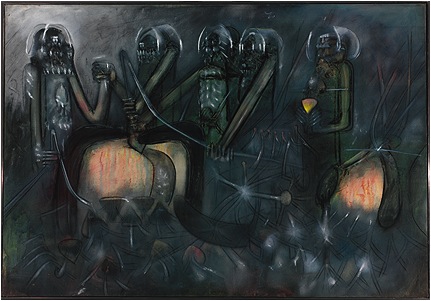Today’s post comes from Calvin Lamothe, class of 2017 and Art Center Student Docent.

Stokers of the Earth, 1953
Oil on Canvas
Gift of Philip C. Johnson, 1955.7
A group of local fifth graders had just finished their tour of the museum and were drawing in the galleries when one of their teachers approached me and asked what was up with the “alien” painting. I was confused, but then she pointed to a painting hanging by itself in the 20th century modernism gallery: Roberto Matta’s Stokers of the Earth. The painting, completed in 1953, depicts interconnected humanoid figures standing around what appears to be a forge. Looking closer, I could see how one could perceive the figures to be extraterrestrial; however, my interpretation of the painting is vastly different. To me, the figures do not represent a far-off life form, but rather that which exists within our own minds.
When researching Stokers, I drew many ideas from Professor John Long’s Art Talk video on the painting (see below). Long tackles the work from the perspective of cognitive science, and argues that Stokers is one of Matta’s many inscape paintings. Matta pioneered this concept of the inscape, or the visual representation of the psyche as an inner landscape. To support his view of the painting as a depiction of the psyche, Long compares the figures, which represent rational thought, to the hearts and forges, which serve as symbols for emotion. He also points to the tubes that connect all of the elements of the painting, emphasizing the importance of emotion in decision-making. At first I saw the painting this way, as a portrayal of the inextricable connection between rational thinking and emotion, but upon closer inspection, it took on a much more sinister quality.
While there is great interconnectedness among the figures and the forges, it seems that the balance between them is slightly skewed. The forges, despite possessing a warm and inviting quality, have traces of the greyish blues and greens that make up the figures and the background. Further, the hearts that are under the larger forge seem to have lost their color, as if they have been exhausted. It is as if the figures are taking the hearts and processing them through the forge, draining them of their emotional quality. In fact, the rightmost figure appears to have taken a fresh heart, possibly from the smaller forge, and is now carrying it to where it will be emptied and join the others. Rather than depicting the interplay of emotion and rationality, the painting seems to demonstrate the suppression of emotion in favor of rational thought.
By delving into our own minds and thinking of how our feelings influence our decisions, we can begin to understand the psychological concept behind Matta’s painting. While it is entertaining to think of the work as a depiction of an apocalyptic world overrun by aliens, closer inspection suggests that the true conflict here lies within, in the constant interplay and tension between emotion and rationality.





Matta’s amazing life and contacts with many of the century’s giants in architecture, literature and art as well as his exposure to the upheaval of WWII and the social turmoil in Latin America all come together in this work. It has almost a science fiction quality, i see the figures as representing faceless colorless evil and I wonder if the ‘forges’ reference the ovens of Nazi death camps. I’m not sure those are “hearts”. Maybe the symbols some people were forced to wear in self identifying. Or not.
Matta’s amazing life and contacts with many of the century’s giants in architecture, literature and art as well as his exposure to the upheaval of WWII and the social turmoil in Latin America all come together in this work. It has almost a science fiction quality, i see the figures as representing faceless colorless evil and I wonder if the ‘forges’ reference the ovens of Nazi death camps. I’m not sure those are “hearts”. Maybe the symbols some people were forced to wear in self identifying. Or not.
Thanks to Calvin Lamothe